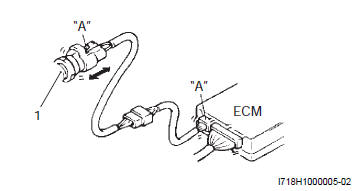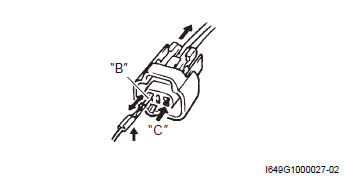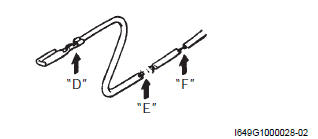Suzuki GSX-R 1000 Service Manual: Open circuit check
Possible causes for the open circuit are as follows. As the cause can exist in the connector/coupler or terminal, they need to be checked carefully.
- Loose connection of connector/coupler.
- Poor contact of terminal (due to dirt, corrosion or rust, poor contact tension, entry of foreign object etc.).
- Wire harness being open.
- Poor terminal-to-wire connection.
When checking system circuits including an electronic control unit such as ecm, etc., It is important to perform careful check, starting with items which are easier to check.
- Disconnect the negative (–) cable from the battery.
- Check each connector/coupler at both ends of the circuit being checked for loose connection. Also check for condition of the coupler lock if equipped.

|
- Using a test male terminal, check the female
terminals of the circuit being checked for contact
tension.
Check each terminal visually for poor contact (possibly caused by dirt, corrosion, rust, entry of foreign object, etc.). At the same time, check to make sure that each terminal is fully inserted in the coupler and locked.
If contact tension is not enough, rectify the contact to increase tension or replace. The terminals must be clean and free of any foreign material which could impede proper terminal contact.

|
- Using continuity inspect or voltage check procedure
as described below, inspect the wire harness
terminals for open circuit and poor connection.
Locate abnormality, if any.

|
 Battery
Battery
Battery connection in reverse polarity is strictly
prohibited. Such a wrong connection will damage the
components of the fi system instantly when reverse
power is applied.
Removing ...
 Continuity check
Continuity check
Measure resistance across coupler “b” (between “a”
and “c” in figure).
If no continuity is indicated (infinity or over limit), the
circuit is open between terminals “a” and “c”.
Dis ...
Other materials:
Precautions
Precautions for driveline / axle
Refer to “general precautions” in section 00 (page 00-1).
Never inspect or
adjust the drive chain while the engine is running.
Caution
do not use trichloroethylene, gasoline or such similar
solvent. These fluids will d ...
Swingarm bearing removal and installation
Removal
Remove the swingarm. Refer to “swingarm removal and installation” .
Remove the swingarm pivot bearings (1) using the
special tool.
Special tool
(a):
09921–20240 (bearing remover set)
Remove the center spacer (2).
Remove the cushion lever bearing (3) usin ...
Rear seat
The seat lock is located under the
left frame cover. To remove the
rear seat, insert the ignition key
into the lock and turn it clockwise.
Raise the front end of the seat
and slide it forward.
To reinstall the seat, slide the seat hooks into the seat hook retainers and
push down firm ...
